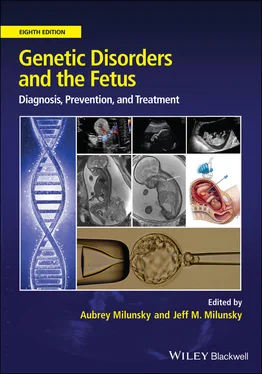Genetic Disorders and the Fetus
Здесь есть возможность читать онлайн «Genetic Disorders and the Fetus» — ознакомительный отрывок электронной книги совершенно бесплатно, а после прочтения отрывка купить полную версию. В некоторых случаях можно слушать аудио, скачать через торрент в формате fb2 и присутствует краткое содержание. Жанр: unrecognised, на английском языке. Описание произведения, (предисловие) а так же отзывы посетителей доступны на портале библиотеки ЛибКат.
- Название:Genetic Disorders and the Fetus
- Автор:
- Жанр:
- Год:неизвестен
- ISBN:нет данных
- Рейтинг книги:4 / 5. Голосов: 1
-
Избранное:Добавить в избранное
- Отзывы:
-
Ваша оценка:
- 80
- 1
- 2
- 3
- 4
- 5
Genetic Disorders and the Fetus: краткое содержание, описание и аннотация
Предлагаем к чтению аннотацию, описание, краткое содержание или предисловие (зависит от того, что написал сам автор книги «Genetic Disorders and the Fetus»). Если вы не нашли необходимую информацию о книге — напишите в комментариях, мы постараемся отыскать её.
Genetic Disorders and the Fetus — читать онлайн ознакомительный отрывок
Ниже представлен текст книги, разбитый по страницам. Система сохранения места последней прочитанной страницы, позволяет с удобством читать онлайн бесплатно книгу «Genetic Disorders and the Fetus», без необходимости каждый раз заново искать на чём Вы остановились. Поставьте закладку, и сможете в любой момент перейти на страницу, на которой закончили чтение.
Интервал:
Закладка:
Table of Contents
1 Cover
2 Dedication Dedicated to Laura and Francia For their love, support, and understanding “Make assurance double sure.” Shakespeare, Macbeth
3 Title Page Genetic Disorders and the Fetus Diagnosis, Prevention, and Treatment EIGHTH EDITION EDITED BY Aubrey Milunsky, mb bch, dsc, frcp, facmg, dch Professor of Obstetrics and Gynecology Tufts University School of Medicine Formerly Professor of Human Genetics, Pediatrics, Obstetrics and Gynecology Boston University School of Medicine Founder and Co-Director, Center for Human Genetics Cambridge, MA, USA Jeff M. Milunsky, md, facmg Professor of Obstetrics and Gynecology Tufts University School of Medicine Formerly Professor of Genetics and Genomics, and Pediatrics Boston University School of Medicine Co-Director, Center for Human Genetics Director, Clinical and Molecular Genetics Cambridge, MA, USA
4 Copyright
5 Preface
6 Acknowledgments
7 Contributors
8 1 Genetic Counseling: Preconception, Prenatal, and Perinatal The burden of genetic disorders and congenital malformations Incidence and prevalence of genetic disorders and congenital malformations Congenital malformations and infant morbidity and mortality The goal and purpose of prenatal diagnosis Prerequisites for genetic counseling Guiding principles for genetic counseling Preconception genetic counseling Genetic counseling as a prelude to prenatal diagnosis Perinatal genetic counseling The efficacy of genetic counseling References
9 2 Preimplantation Genetic Testing Approaches to preimplantation genetic testing Preimplantation genetic analysis Ethical and legal issues Conclusion References
10 3 Amniotic Fluid Constituents, Cell Culture, and Neural Tube Defects Introduction Amniotic fluid Amniotic fluid cell culture References
11 4 Molecular Aspects of Placental Development Overview Placental structure Placental development and function Placental insufficiency Fetal growth restriction Preeclampsia Genetic findings associated with molar changes in the placenta Placental mesenchymal dysplasia DNA methylation studies in the placenta and their clinical application Epigenetic studies in the placenta and environment The placenta as a predictor of child health Further considerations References
12 5 Fetal Origins of Adult Health and Disease Introduction Epigenetics and programming Energy‐balance programming: under‐ and overnutrition Environmental toxins Maternal stress and anxiety Glucocorticoids and prematurity Organ‐specific programming effects Conclusion References
13 6 Maternal Serum Screening for Chromosomal Abnormalities and Neural Tube Defects Chromosomal abnormalities Neural tube defects Screening and prenatal diagnosis Widely used markers Additional markers Marker distributions in Down syndrome, neural tube defect, and unaffected pregnancies Risk screening for Down syndrome Age‐specific Down syndrome risk at term Down syndrome risk at the time of the test Down syndrome likelihood ratios Modeling performance of Down syndrome screening Established multimarker Down syndrome policies Model performance of neural tube defect screening Prospective confirmation of the Down syndrome model Further multimarker Down syndrome strategies Ultrasound screening for OSB Other Down syndrome markers Clinical factors Edwards syndrome (trisomy 18) Other conditions associated with altered markers Planning a program Conclusion Acknowledgments References
14 7 Noninvasive Screening for Aneuploidy Using Cell‐Free Placental DNA Introduction Cell‐free DNA Performance of cell‐free DNA screening Sex chromosome aneuploidy Cell‐free DNA screening approaches Cell‐free DNA test failures False‐positive cell‐free DNA results and incidental findings False‐negative cell‐free DNA results Cell‐free DNA screening for microdeletion syndromes Genome‐wide cell‐free DNA screening Pretest counseling Post‐test screening Comparison of cell‐free DNA screening to traditional screening Use of prenatal ultrasound in the setting of cell‐free DNA Multiple gestations Cell‐based noninvasive prenatal testing Conclusion References
15 8 Noninvasive Prenatal Diagnosis and Screening for Monogenic Disorders Using Cell‐Free DNA Introduction Biology and characteristics of cell‐free DNA in maternal blood General approaches for testing of single‐gene disorders by fetal cell‐free DNA analysis Current status of noninvasive single‐gene testing by cell‐free DNA analysis Noninvasive prenatal diagnosis of monogenic disorders Noninvasive prenatal screening using panels of single‐gene disorders by cell‐free DNA analysis Clinical implementation: ethical and social issues Summary and future directions References
16 9 Amniocentesis, Chorionic Villus Sampling, and Fetal Blood Sampling Introduction Amniocentesis Chorionic villus sampling Fetal blood sampling Cardiocentesis References
17 10 Prenatal Diagnosis of Neural Tube Defects Biology of α‐fetoprotein Amniotic fluid α‐fetoprotein Amniotic fluid acetylcholinesterase Recommendations for prenatal diagnosis of NTDs using AFAFP and AChE assays Other techniques to detect neural tube defects Primary prevention of neural tube defects Complications and life expectancy References Additional references
18 11 Prenatal Diagnosis of Chromosomal Abnormalities through Chorionic Villus Sampling and Amniocentesis The incidence of chromosomal abnormalities detected by conventional cytogenetics Indications for prenatal cytogenetic diagnosis Interpretation issues: chromosome mosaicism and pseudomosaicism Interpretation issues: chromosome rearrangements Interpretation issues: chromosome polymorphisms, common inversions, and other structural variations Interpretation issues: maternal cell contamination Factors affecting diagnostic success rate and accuracy Technical standards for prenatal cytogenetics laboratories Error rates in prenatal cytogenetic diagnosis Discordance between karyotyping and molecular genetic testing Conclusion Acknowledgments References
19 12 Prenatal Diagnosis of Sex Chromosome Abnormalities Incidence Ascertainment bias Patterns of inheritance Prenatal diagnosis Turner syndrome Klinefelter syndrome Triple X and poly‐X syndromes 47,XYY males Polysomy Y karyotypes Structural abnormalities of the X chromosome Structural abnormalities of the Y chromosome Disorders of sex development Conclusion References
20 13 Prenatal Diagnosis of Chromosomal Abnormalities: From Karyotype to Microarray The study and impact of chromosome abnormalities in humans Traditional cytogenetic testing: analysis of the G‐banded metaphase Incidence and spectrum of chromosome abnormalities observed in prenatal diagnosis Rapid identification of the common aneuploidies Chromosome microarray analysis adds diagnostic yield over karyotyping and rapid aneuploidy techniques Types of microarrays Microarray design for clinical testing Interpreting and reporting of CMA results Factors affecting CMA diagnostic yield CMA in routine pregnancies CMA in pregnancies with ultrasound anomalies CMA versus karyotyping: additional points to consider CMA and genetic counseling Conclusion References
21 14 Molecular Genetics and Prenatal Diagnosis Diagnostic methods: use, limitations, and pitfalls Clinical caveats, cautions, limitations, and pitfalls Prenatal diagnosis of mitochondrial disorders Reporting incidental (secondary) results Ethical considerations in prenatal testing References
22 15 Prenatal Diagnosis of Cystic Fibrosis Genetics and epidemiology Clinical features Diagnosis Treatment Discovery of the cystic fibrosis gene Genotype–phenotype correlation Congenital bilateral absence of the vas deferens Modifier genes Ethnic variation in mutation frequencies Development and implementation of public policy for CF population carrier screening and the core mutation panel Laboratory methods Expanded panels Outcomes of the CF carrier screening program Special prenatal diagnosis situations Future directions References
Читать дальшеИнтервал:
Закладка:
Похожие книги на «Genetic Disorders and the Fetus»
Представляем Вашему вниманию похожие книги на «Genetic Disorders and the Fetus» списком для выбора. Мы отобрали схожую по названию и смыслу литературу в надежде предоставить читателям больше вариантов отыскать новые, интересные, ещё непрочитанные произведения.
Обсуждение, отзывы о книге «Genetic Disorders and the Fetus» и просто собственные мнения читателей. Оставьте ваши комментарии, напишите, что Вы думаете о произведении, его смысле или главных героях. Укажите что конкретно понравилось, а что нет, и почему Вы так считаете.












